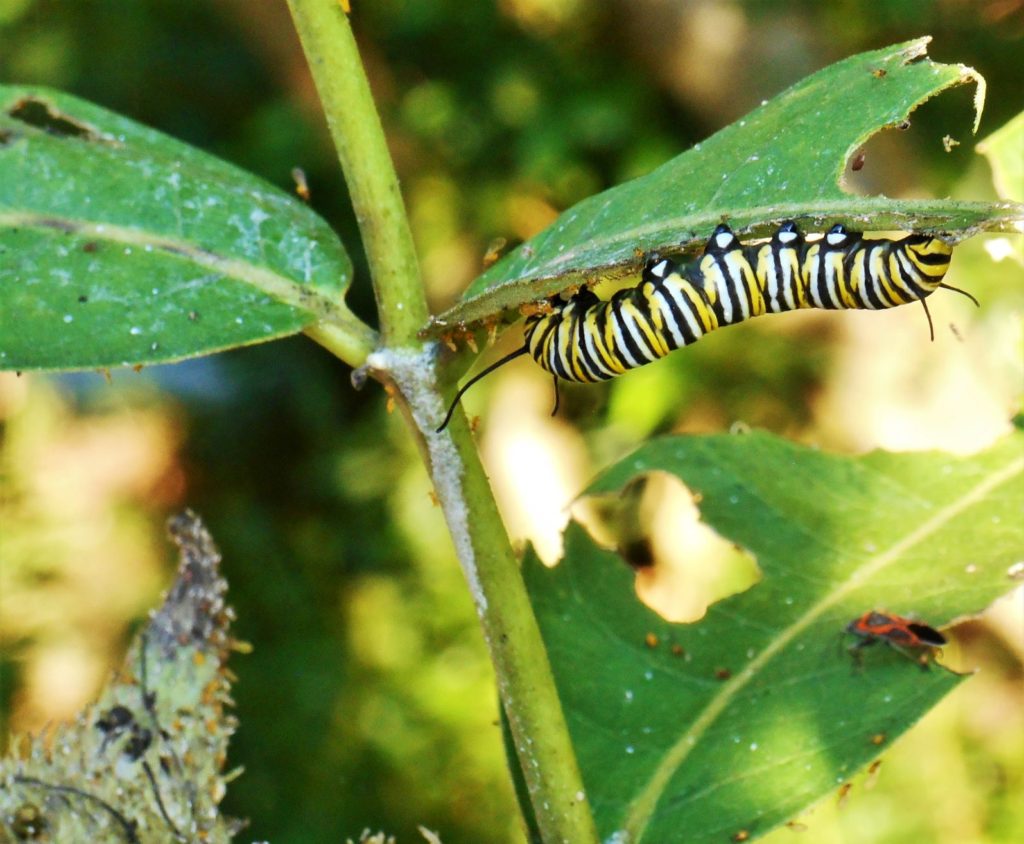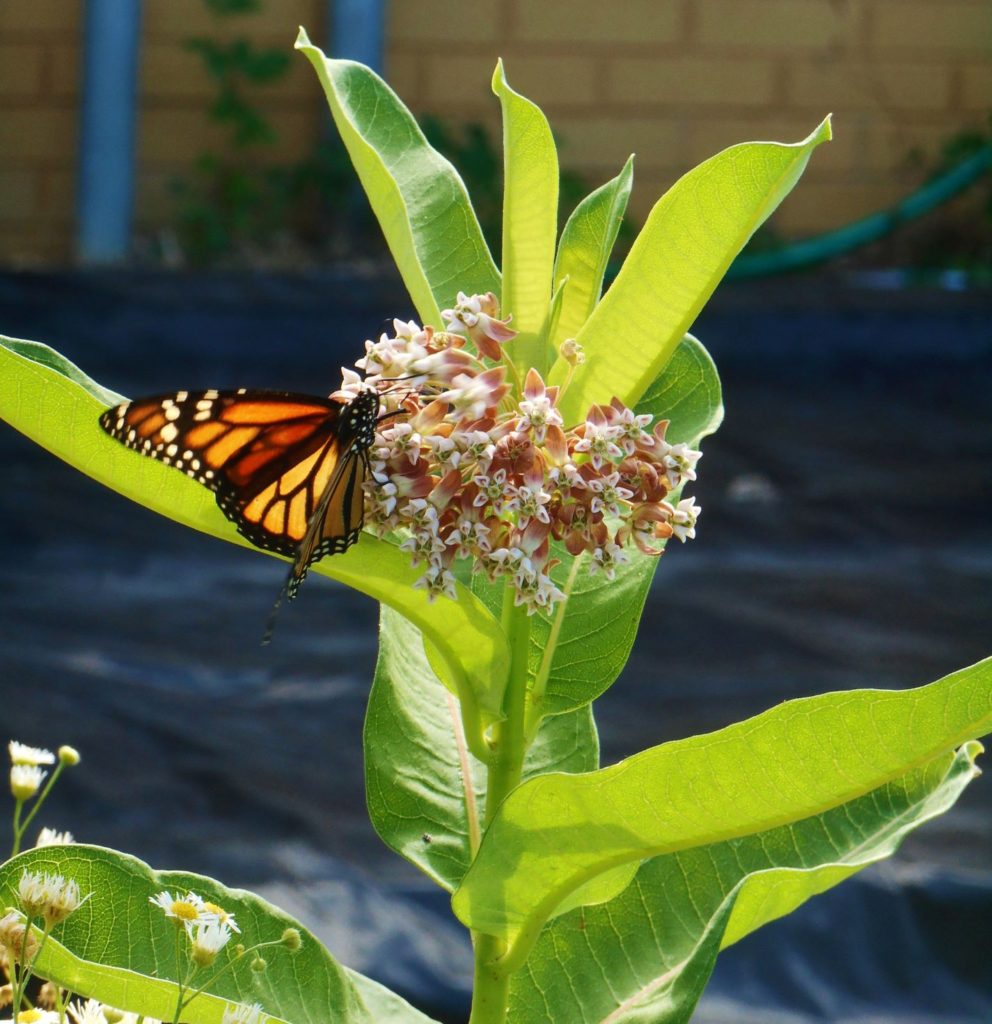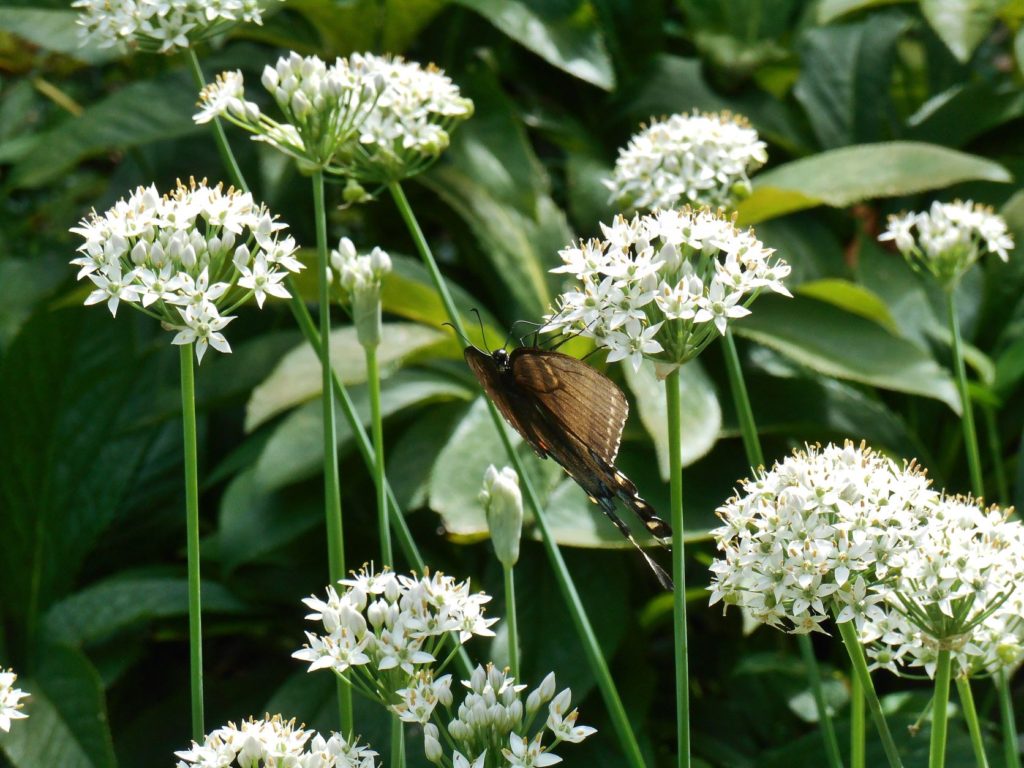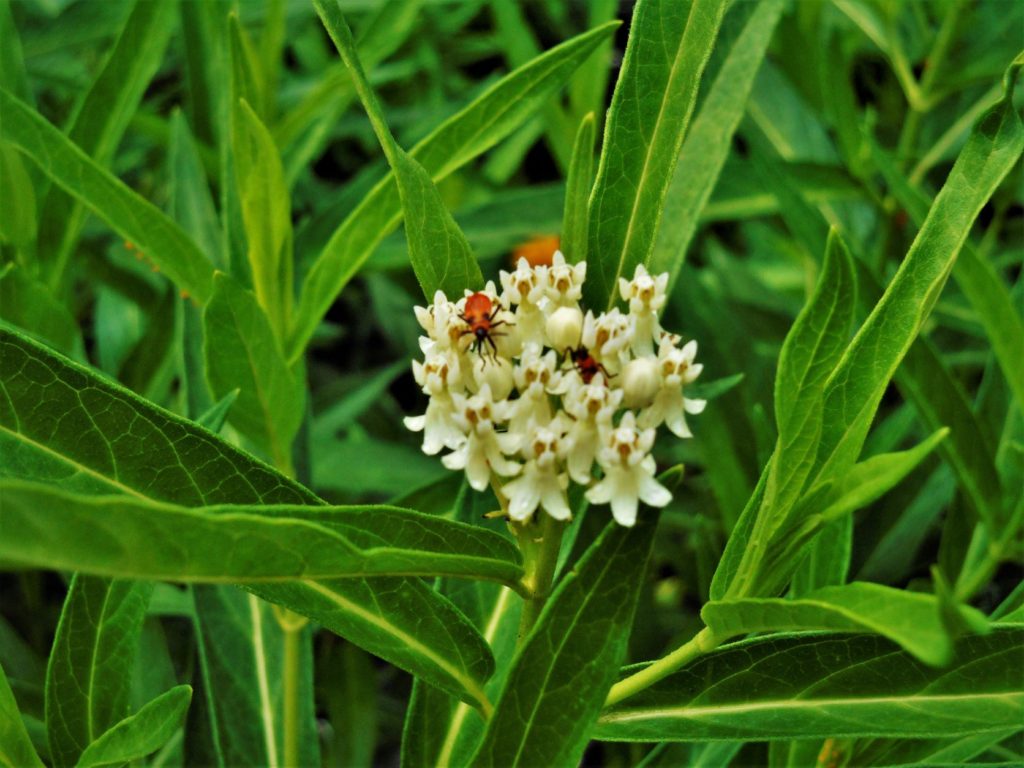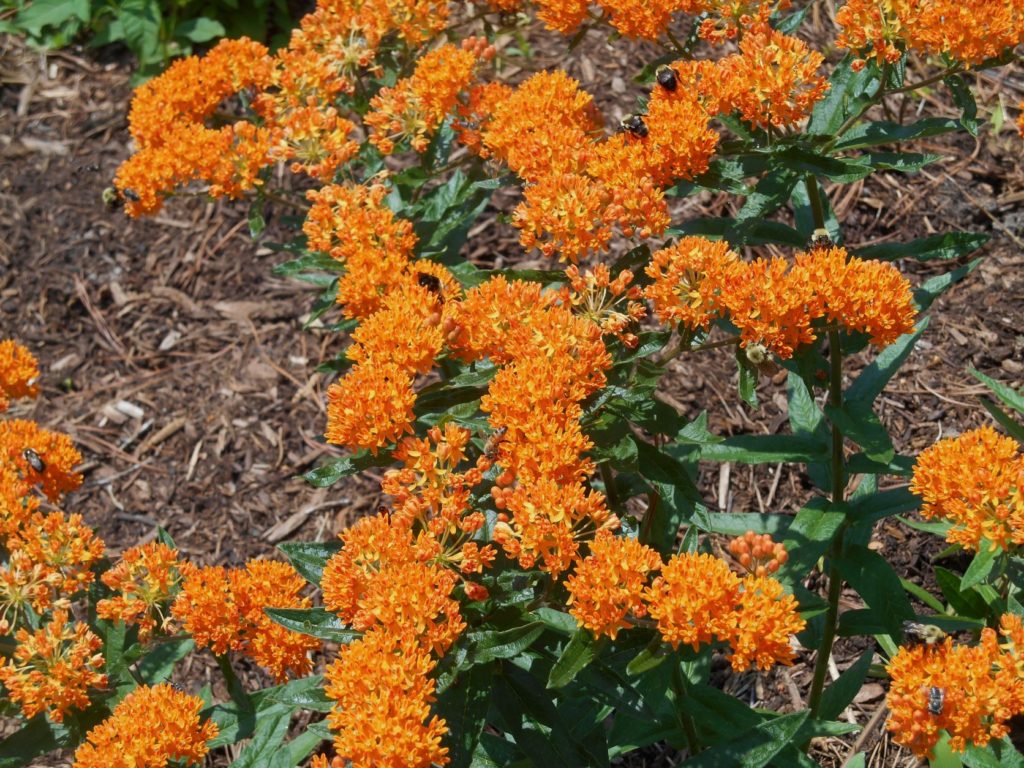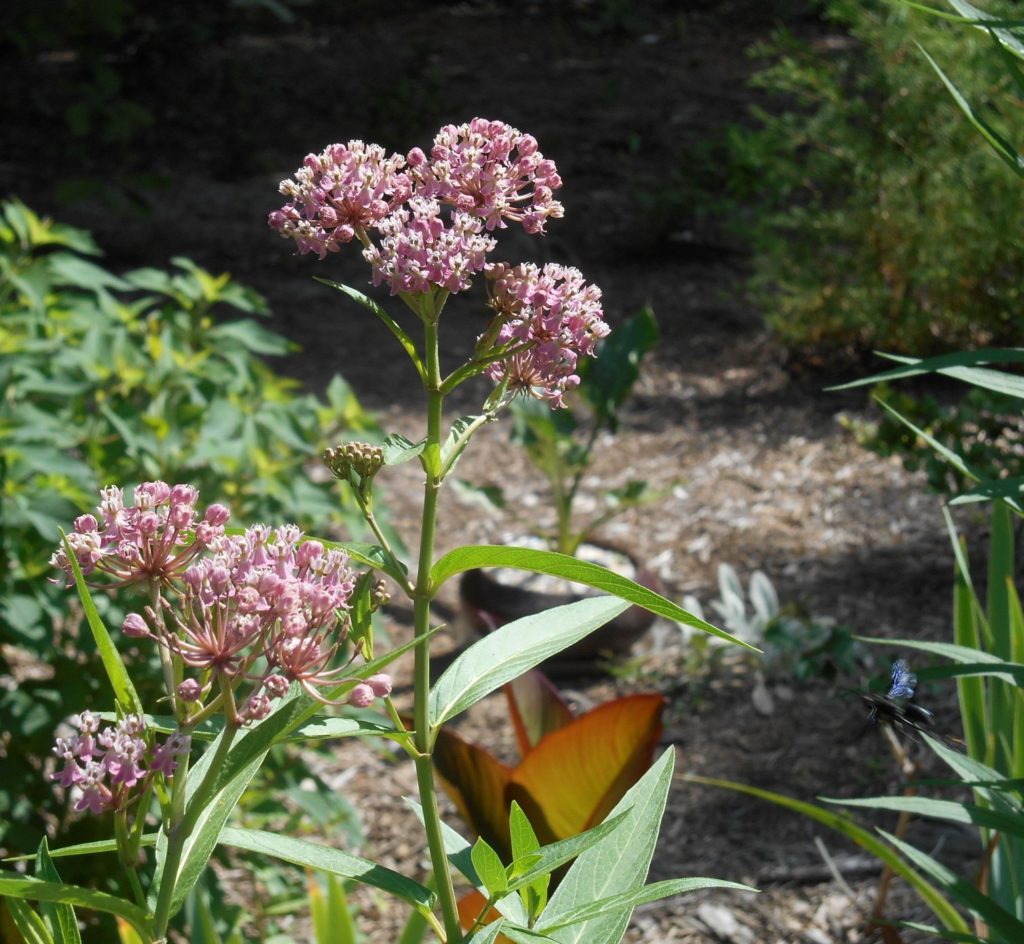Designing Plantings to Host Butterflies and Moths
A friend was excited to buy milkweed plants at a WBG plant sale several years ago. They aren’t easy to find commercially, and few people raise them from seed. When I saw her again a few weeks later, I inquired about how her plants were doing.
“Oh, I must have done something wrong. They’re not looking so good. Most of the leaves have disappeared,” she replied.
I quickly reassured her that it was unlikely she had done anything wrong, and that her plants should soon produce some new leaves. The milkweed plants we had sold that day were already populated with Monarch cats. She had gotten both milkweed and Monarchs without realizing it.
Becoming Part of the Solution to Butterfly Decline
When we garden for wildlife, we are choosing plants to feed and shelter the animals we hope to attract. Milkweed, Asclepias species, is the one genus that Monarch butterfly larvae will eat. So when we plant milkweed, we expect to find egg clusters on the leaves, followed by caterpillars eating the leaves. Milkweed also blooms, supporting many different pollinator species, including native bees, with nectar.
Gardeners and naturalists concerned about the declining number of Monarch butterflies may want to plant Asclepias to support the next generation. Providing a flower-filled, nectar-rich garden is very helpful. Providing host plants and a safe habitat for butterflies to lay their eggs, and for larvae to feed and grow, is vital for supporting dwindling populations of butterflies.
It may feel counter-intuitive to plant with the intention of having little caterpillars come and consume our planting. Our plants look a bit ragged for a few weeks as the caterpillars grow. What a fascinating process to watch, especially when there are children to witness this miracle of transformation! The cats grow very quickly, and rarely do they kill their host. Monarchs may raise as many as 4-6 generations in a single summer in our area.
Most of the Asclepias species available locally are Eastern North America natives, and all are easy to grow. Give milkweed a well-drained, sunny spot and it will flourish. While milkweed normally grows in open areas or in borders, it can also be grown in containers and raised bed plantings in combination with other nectar and foliage plants.
There are nearly a dozen species of milkweed native to Virginia, but only a few are commonly available on the market. A greater selection can be bought from mail-order nurseries. Recommended varieties are described at the end of this post.
Other Host Plants for Mixed Plantings
In addition to milkweed, there are other host plants to include in plantings to support butterflies. Parsley, fennel, dill, carrot, rue, anise and Queen Anne’s lace support several swallowtail species as host plants, and a wide variety of pollinators.
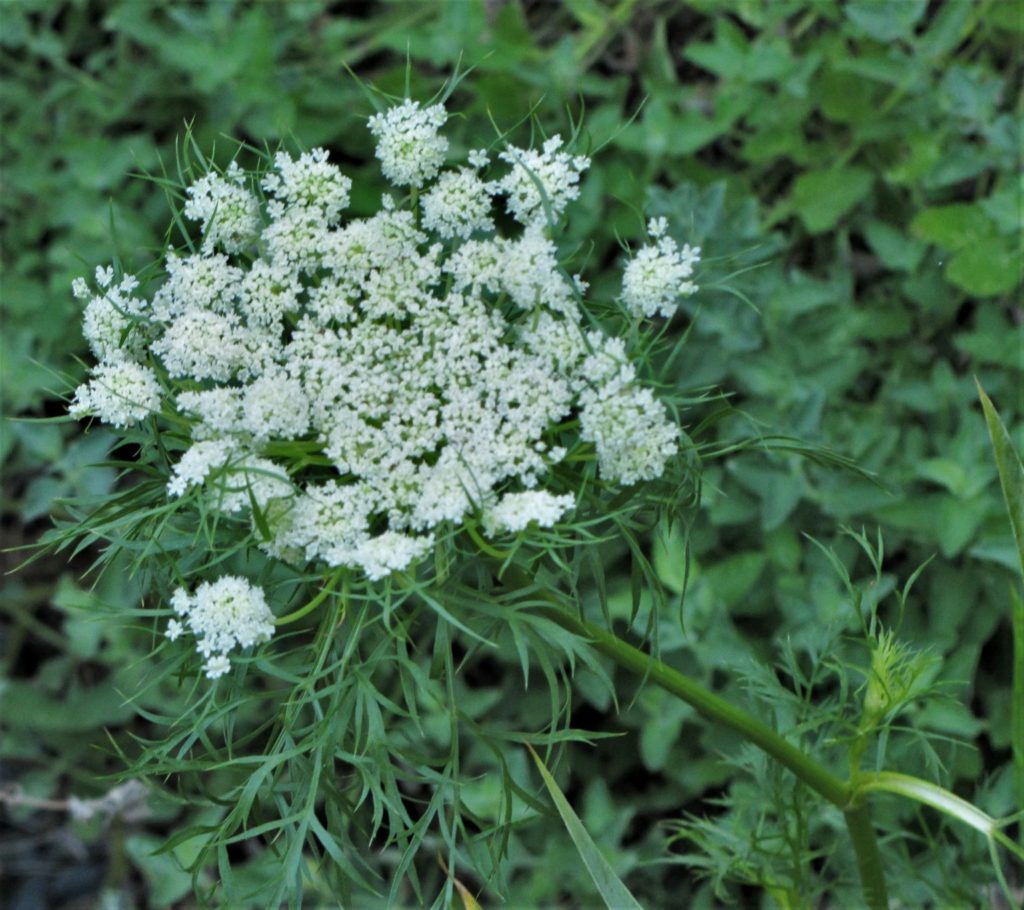
Whole carrots, planted in the spring, will grow into 3′-4′ tall plants and bloom by mid-summer. Daucus carota
Since carrots are biennials, you can buy carrots which still have some of their tops intact at the grocery store or farmer’s market, and plant them vertically, even with the top of the soil, expecting them to leaf out and bloom that season.
Paw paw trees, Asimina triloba, host Zebra Swallowtail butterflies. Though they will grow to 30’ tall, small ones may be grown in containers for their first few years. The red flowers in spring are very ornamental and they produce edible fruit. Native trees such as oak, maple, and tulip trees host more butterfly and moth species than any other type of plant.
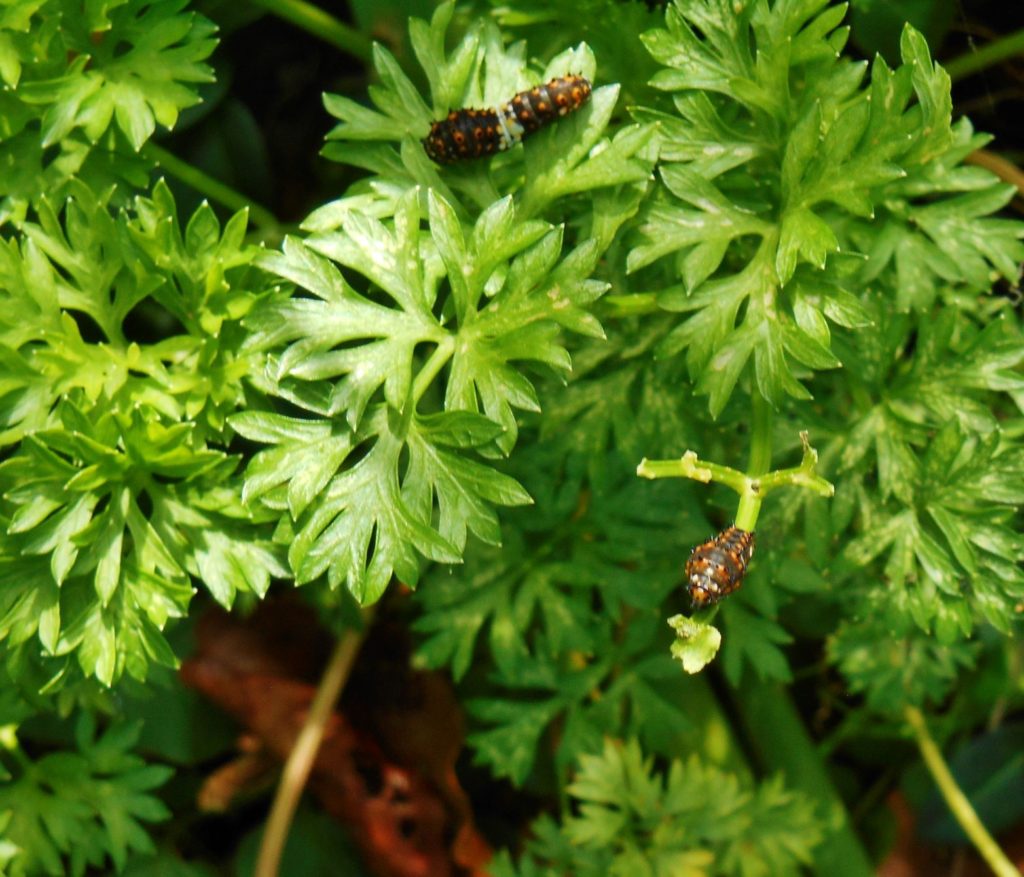
Parsley, dill, fennel, anise and rue serve as host plants to several species of swallowtail butterflies.
Dutchman’s pipe vine, Aristolochia macrophylla, host to the Pipevine Swallowtail butterfly, is a large, very poisonous vine to 40’ tall and 20’ wide. Grow it only if there is enough space on a fence or trellis and if there’s no chance that children will ingest it, as it causes kidney failure.
Wildlife Hospitality
Host and nectar plants buzz with life all summer. It is remarkable how many different species of butterflies, moths, bees, hummingbirds, and other insects visit daily.
Where insects gather, birds will gather, too. Pull up a chair and enjoy the show! Put a shallow saucer of wet sand or gravel nearby for the insects to drink, and keep a field guide handy to identify the visitors. Just remember to never use insecticides around wildlife plantings.
How to Create a Mixed Planting to Host Butterflies
To create your own planting to support butterflies, begin with a prepared raised bed, or the largest container you can manage for your planting, at minimum 12” deep. Half-barrels, tubs, and larger pots allow for more plants and hold moisture longer. Place large containers where they will grow before filling them with soil and planting them. They will be extremely heavy once filled. Most plants suggested to support pollinators need 6 or more hours of sun each day.

You’ll be amazed by the fascinating pollinators who turn up to feed when you provide for their basic needs.
Use good quality potting soil mixed with compost or a good commercial topsoil. Add some builder’s sand to improve drainage if the species you plant require good drainage. You might want to add a slow-release fertilizer such as Plant-Tone or Bio-Tone to the soil mix to support flowering.
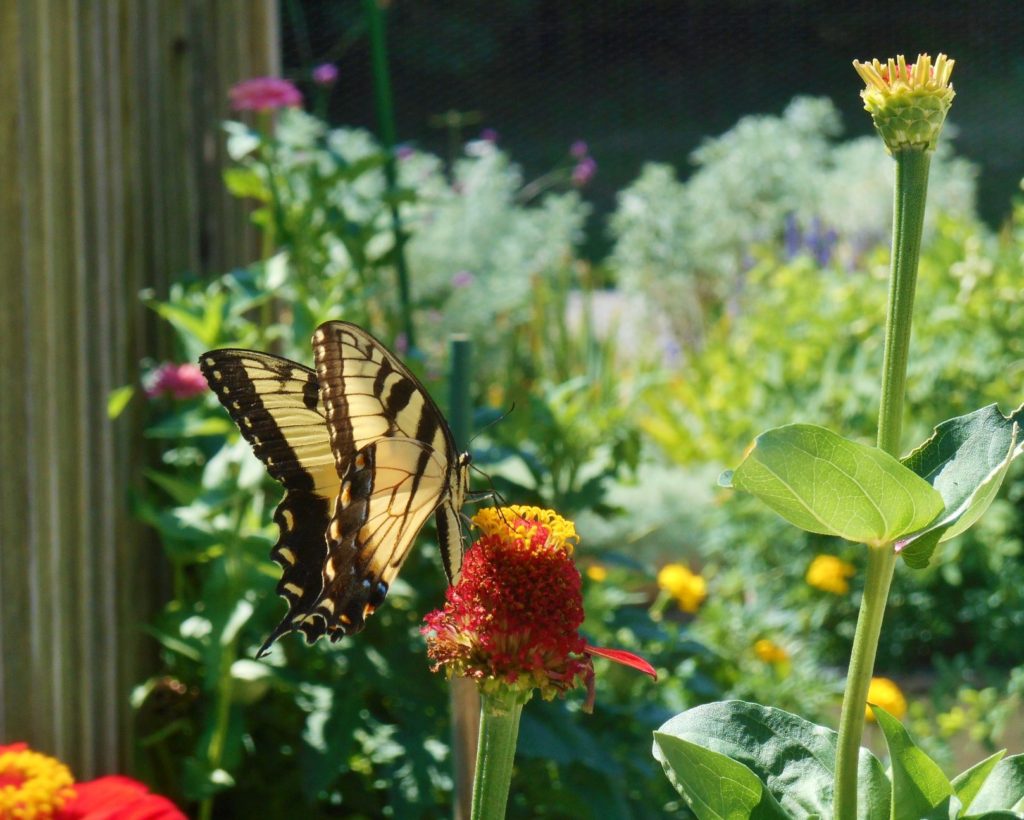
Eastern Tiger Swallowtail Butterflies love Zinnias. Blue on the hind wings indicates the butterfly is a female.
In addition to host plants, which will probably have their leaves eaten during the season, include some non-host flowering plants to keep the planting attractive and productive over a long season.
Recommended annuals for pollinators include: Zinnias, Cosmos, Coleus, Cleome, Penta, Cuphea ignea, basil, and tender Salvias. Black-eyed Susan vine, Thunbergia alata, can trail or grow up a support. Vining sweet peas in the spring, and moonflowers or runner beans in summer, will also attract pollinators.
Recommended perennials for pollinators include: Verbena, Lantana, Echinacea, Yarrow, Nepeta, Allium, Agastache, Salvia, and Rudbeckia. Perennial herbs like rosemary, thyme, lavender and germander support pollinators early and late in the season and provide some evergreen structure to the planting.
Find Success by Minding the Details
Leave enough space between plants for healthy growth, and mulch the finished planting with pea gravel, granite dust, a product like Espoma Soil Perfector, or fine bark mulch. Mulch keeps the soil moist and cool, prevents soil from splashing up onto the plants and helps control disease. You can install a capped PVC pipe with holes drilled in it at 2” intervals to make watering easier in very large containers.
Selecting the plants to include in your container butterfly garden, and planting them all, will be the most challenging part of this project. Once they begin to grow, a little deadheading and trimming will keep your arrangement going until frost.
If you are new to growing milkweed, read on for more information about the needs of several commonly available species.
The following species of milkweed are attractive, bloom over a long season, and may be purchased locally:
Asclepias incarnata, swamp milkweed, prefers wet areas near ponds, creeks, or other waterways, but can adapt to many types of soil. It prefers neutral to acidic soil and will grow on loam or clay. Flowers are white or pink on a plant 3’-5+’ and 2’-3’ wide. Like other native Asclepias varieties, it is an herbaceous perennial which prefers full to part sun. It is mildly poisonous and deer resistant. Zones 3-9
Asclepias incarnata subsps. Pulchra Eastern swamp milkweed can be found in bogs, swamps, along creeks and streams, and in low-lying areas with poor drainage. Its flowers have a slightly deeper pink color, and its leaves are broader than the species. It grows 2’-4’ tall with an erect, multi-stemmed form. Zonse 4-9
Asclepias tuberosa, butterfly milkweed, grows 1’-2’ feet tall and about 18” across in average to poor, dry soil and full to part sun. It is a long lived, drought tolerant, tuberous perennial that takes about three years to flower from seed. Flowers are orange. It supports several lepidoptera species in addition to Monarch butterflies, and it provides nectar to many pollinating insects, including specialist native bees. Deer and rabbits rarely graze Asclepias as it is somewhat poisonous. Zones 3-9

You’ll be amazed by the fascinating pollinators who turn up to feed when you provide for their basic needs.
Asclepias curassavica, known as tropical milkweed, is native to Mexico and tropical regions of America. This is one of the most ornamental milkweed species and some varieties on the market have variegated leaves and red-orange flowers. It supports many pollinators, including hummingbirds. There is some controversy over using A. curassavica outside of its native range out of concern that Monarchs will linger too late in the fall before beginning their migration, where it is available.

Tropical milkweed, A. curassavica, is still in a nursery pot and just beginning to bloom. Variegated foliage on some varieties makes this milkweed even more ornamental.
Tropical milkweed grows 2’-3’ tall and 2’ wide with narrow leaves and upright growth in full to part sun. It prefers moist, fertile soil rich in organic material. Like other milkweed species, the soil needs to drain well, and the plant rots easily in soil that doesn’t drain. It grows a long taproot, which makes it difficult to move once established, and is grown as an annual north of Zone 8. It is moderately poisonous and so won’t be bothered by deer or rabbits, but it can pose a danger to curious pets that nibble it. Zones 8a-11
Asclepias syriaca, common milkweed, grows vigorously in average soil in full or part sun. It can tolerate thin, sandy, dry and rocky soil, and can help stop erosion on banks. It is drought tolerant. It will spread and cover as much space as you can give it over several years. Each plant grows 2’-5’ tall and may bloom in pink, lavender, white, or green over a long season. This milkweed supports many pollinators, including native bees, and hosts Monarch butterflies. It is moderately poisonous and won’t be grazed by deer or rabbits. Zones 3-9
All Photos by E. L. McCoy



